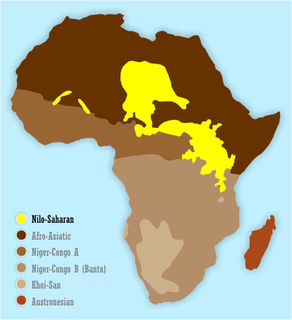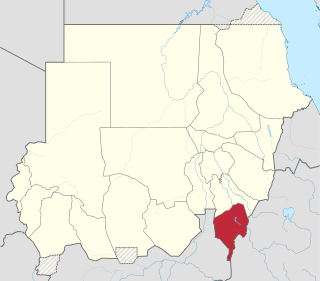Related Research Articles

The Nilo-Saharan languages are a proposed family of African languages spoken by some 50–60 million people, mainly in the upper parts of the Chari and Nile rivers, including historic Nubia, north of where the two tributaries of the Nile meet. The languages extend through 17 nations in the northern half of Africa: from Algeria to Benin in the west; from Libya to the Democratic Republic of the Congo in the centre; and from Egypt to Tanzania in the east.
Operation Moses was the covert evacuation of Ethiopian Jews from Sudan during a civil war that caused a famine in 1984. Originally called Gur Aryeh Yehuda by Israelis, the United Jewish Appeal changed the name to “Operation Moses.”

Blue Nile is one of the eighteen states of the Republic of Sudan. It was established by presidential decree nº 3 in 1992 and is named after the Blue Nile River.
Shabo is an endangered language and likely language isolate spoken by about 400 former hunter-gatherers in southwestern Ethiopia, in the westernmost part of the Southern Nations, Nationalities, and People's Region.
The Nuer language is a Nilotic language of the Western Nilotic group. It is spoken by the Nuer people of South Sudan and in western Ethiopia. The language is very similar to Dinka and Atuot.

The Koman languages are a small close-knit family of languages located along the Ethiopia–Sudan border with about 50,000 speakers. They are conventionally classified as part of the Nilo-Saharan family. However, due to the paucity of evidence, many scholars treat it as an independent language family. Among scholars who do accept its inclusion within Nilo-Saharan, opinions vary as to their position within it.

Bonga is a town, district and capital of the South West Region in Ethiopia. Located in the Keffa Zone upon a hill in the upper Barta valley, it has a latitude and longitude of 7°16′N36°14′E with an elevation of 1,714 meters above sea level. Note that there is another town in Ethiopia named "Bonga", near Gambela.
The languages of Ethiopia include the official languages of Ethiopia, its national and regional languages, a large number of minority languages, as well as foreign languages.

The Berta (Bertha) or Funj are an ethnic group living along the border of Sudan and Ethiopia. They speak a Nilo-Saharan language that is not related to those of their Nilo-Saharan neighbors. Their total Ethiopian population is about 183,000 people.
The Uduk are a Nilo-Saharan group from eastern Sudan. They call themselves Kwanim Pa and are culturally and linguistically related to neighboring communities, such as the Gumuz and the Kwama from the Sudan-Ethiopia borderland. Due to the recent war in southern Sudan they have been forced to emigrate to other countries, especially Ethiopia. Following the peace agreement in 2005, some Uduk have started to return home.

The Kwama, are a Nilo-Saharan-speaking community living in the Sudanese-Ethiopian borderland, mainly in the Mao-Komo special woreda of the Benishangul-Gumuz Region in Ethiopia. They belong, culturally and linguistically, to the Koman groups, which include neighboring communities such as the Uduk, Koma, and Opuuo. Although they traditionally occupied a larger territory, they have been forced to move to marginal, lowland areas by the Oromo from the 18th century onwards. In some villages Kwama, Oromo and Berta live together. The Kwama are often called "Mao" by other groups, especially by the Oromo. The people who live in the southern area and near the Sudanese borderland often call themselves "Gwama" and use the term "Kwama" to refer to those living further to the south and in Sudan. These other "Kwama" are usually known by anthropologists as Koma or Komo. In recent years, many people belonging to this ethnic group have been resettled by the Ethiopian state in order to provide them with clinics and schools.
Moronene is an Austronesian language spoken in Bombana Regency, Southeast Sulawesi, Indonesia. It belongs to the Bungku–Tolaki branch of the Celebic subgroup.
Komo is a Nilo-Saharan language spoken by the Kwama (Komo) people of Ethiopia, Sudan and South Sudan. It is a member of the Koman languages. The language is also referred to as Madiin, Koma, South Koma, Central Koma, Gokwom and Hayahaya. Many individuals from Komo are multilingual because they are in close proximity to Mao, Kwama and Oromo speakers. Komo is closely related to Kwama, a language spoken by a group who live in the same region of Ethiopia and who also identify themselves as ethnically Komo. Some Komo and Kwama speakers recognize the distinction between the two languages and culture, whereas some people see it as one "ethnolinguistic" community. The 2007 Ethiopian census makes no mention of Kwama, and for this reason its estimate of 8,000 Komo speakers may be inaccurate. An older estimate from 1971 places the number of Komo speakers in Ethiopia at 1,500. The Komo language is greatly understudied; more information is being revealed as researchers are discovering more data about other languages within the Koman family.
Shilluk is a language spoken by the Shilluk people of South Sudan and Sudan. It is closely related to other Luo languages. The term Shilluk is a pronunciation of Arabic origin.
Gaam (Gaahmg), also known as Ingessana, (Me/Mun)Tabi, Kamanidi, or Mamedja/Mamidza, is an Eastern Sudanic language spoken by the Ingessana people in the Tabi Hills in eastern Sudan, near Ethiopia. It was considered an isolate within Eastern Sudanic until the other Eastern Jebel languages were discovered in the late 20th century. Dialects are Soda (Tao), Kukur (Gor), Kulang, Buwahg (Buek).
Ganza is an Omotic language spoken in the Al Kurumik district of the Blue Nile (state) in Sudan and in the western Benishangul-Gumuz region of Ethiopia, specifically in the village districts of Penishuba and Yabeldigis.
Kursav is a divergent and nearly extinct Madang language of the Adelbert Range of Papua New Guinea. It was once placed in the now-defunct Brahman branch of Madang. Daniels (2017) identifies Gants as its closest relative.
Gumuz is a dialect cluster spoken along the border of Ethiopia and Sudan. It has been tentatively classified within the Nilo-Saharan family. Most Ethiopian speakers live in Kamashi Zone and Metekel Zone of the Benishangul-Gumuz Region, although a group of 1,000 reportedly live outside the town of Welkite. The Sudanese speakers live in the area east of Er Roseires, around Famaka and Fazoglo on the Blue Nile, extending north along the border. Dimmendaal et al. (2019) suspect that the poorly attested varieties spoken along the river constitute a distinct language, Kadallu.
South Sudanese refugees are persons originating from the African country of South Sudan, but seeking refuge outside the borders of their native country. The world's youngest independent country has a recent and troubled history of prolonged conflicts and ecosystem mismanagement such as overlogging, which has led to desertification. These forces have resulted not only in violence and famine, but also the forced migration of large numbers of the population, both inside and outside the country's borders. South Sudan was cited as the largest refugee crisis in 2016, being the world's third largest, followed by Syria and Afghanistan.
Wendy Rosalind James, is a British retired social anthropologist and academic. She was Professor of Social Anthropology at the University of Oxford from 1996 to 2007, and President of the Royal Anthropological Institute from 2001 to 2004.
References
- ↑ Uduk at Ethnologue (17th ed., 2013)
- ↑ Killian 2015, pp. 4f
- Don Killian (2015) "Topics in Uduk Phonology and Morphosyntax" Ph.D. thesis. University of Helsinki.
- Don Killian and Harald Hammarström (2010) "Notes on the morphosyntax of Uduk"
- Bender, M. L. 1983. Proto-Koman phonology and lexicon. Afrika und Übersee 66, 259–297.